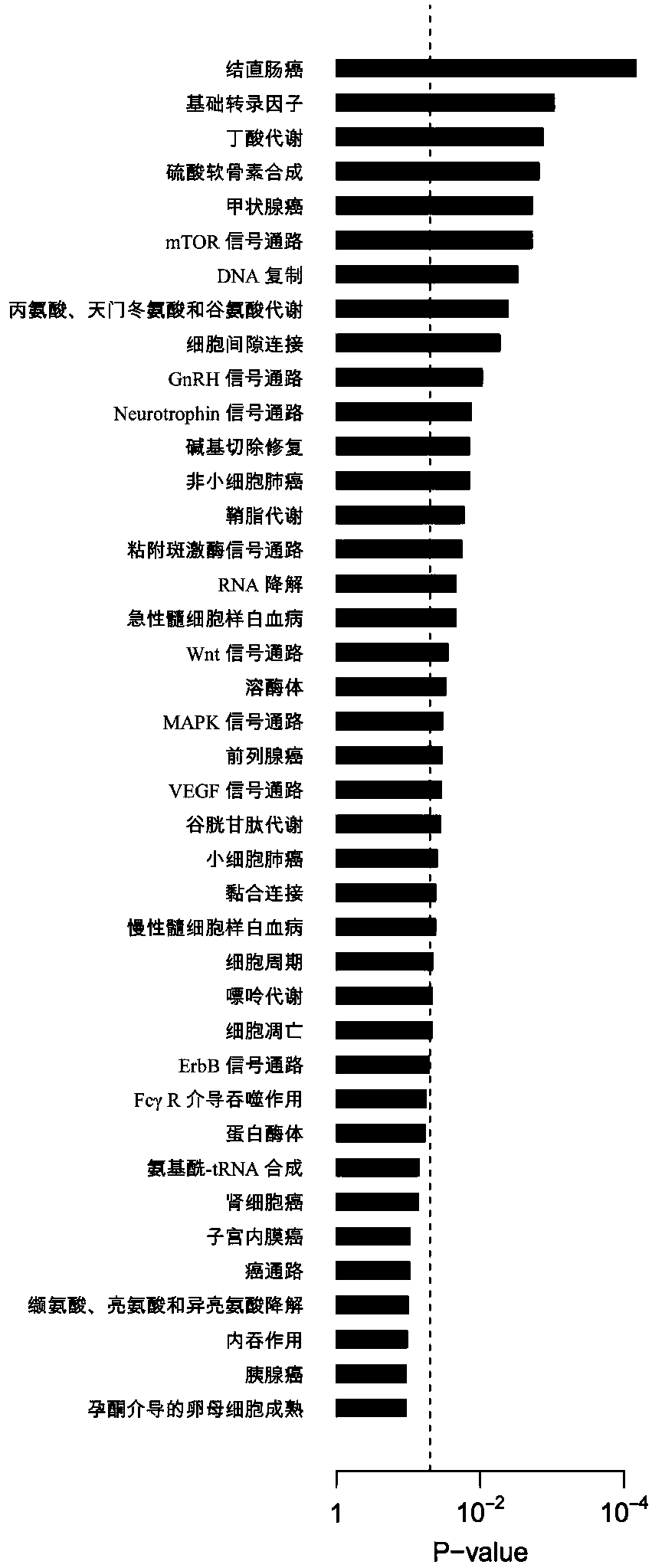Peripheral blood mRNA marker for predicting prognosis of patients with lung adenocarcinoma and screening method and application thereof
A screening method and technology for lung adenocarcinoma, applied in the field of medical molecular biology technology and clinical medicine, can solve problems such as tumors, oncogenes, and tumor suppressor gene expression disorders
- Summary
- Abstract
- Description
- Claims
- Application Information
AI Technical Summary
Problems solved by technology
Method used
Image
Examples
Embodiment 1
[0055] Screening method for a group of gene markers that can be used to predict the prognosis of patients with lung adenocarcinoma:
[0056] (1) In order to screen the gene markers for predicting the prognosis of patients with lung adenocarcinoma, the gene expression profiles of wild-type (WT) human lung cancer cell lines and Nrf2 knockout (KD) human lung cancer cell lines were first compared and analyzed using the SAM algorithm . Set the analysis conditions of false positive rate 1.5, the results are shown in figure 1 . figure 1 It showed that compared with the wild-type human lung cancer cell line, 2160 genes were up-regulated and 1643 genes were down-regulated in the Nrf2KD cell line.
[0057] (2) Carry out KEGG pathway analysis (Fisher's exact test) on differentially expressed genes, see figure 2 . figure 2 It was shown that the above-mentioned dysregulated Nrf2 target genes were mainly enriched in cancer-related KEGG entries, such as "colorectal cancer", "prostate ...
Embodiment 2
[0061] The identification method of the gene markers described in Example 1 for predicting the prognosis of patients with lung adenocarcinoma:
[0062] In this example, the 66 gene combinations described in Example 1 are defined as "66-gene markers", and the risk score of each patient in the lung adenocarcinoma discovery population database is performed using the "66-gene markers". Among them, "ALDOA, ALYREF, AP1S1, AP2B1, ARNTL2, AVEN, BYSL, C15orf48, C1orf43, CDK5, CENPH, DDX41, DLAT, DPP3, DPY19L1, ERO1L, FOSL1, FOSL2, GARS, GFPT2, GMFB, GNAI3, IPO4, MAPKAP1 , MAX, METTL5, MRPS12, NAMPT, NOP16, PFKP, PLAU, PPIF, PSMB5, PSMC6, PSME3, RALA, RBM28, RRM1, RRM2, SDHC, SEH1L, SYNCRIP, TIMM50, TOMM5, UPP1, VEGFA, and VTI1B" The weight of the gene is "1"; each of "ABI3BP, ACACB, ANAPC16, C17orf103, ECHDC2, FAM117A, HSD17B14, ITPR2, KIAA0232, METTL7A, MPHOSPH8, PTCH1, RBBP6, RBPMS, RPS6KA5, TTC28, USP3, ZBTB4 and ZNF70" Genes have a weight of "-1". In this embodiment, the risk v...
Embodiment 3
[0071] Verification and application of the "66-gene marker" described in Example 2 to predict the prognosis of lung adenocarcinoma in an independent sample set:
[0072] In order to verify the effectiveness of the "66-gene marker" in predicting the prognosis of lung adenocarcinoma, the expression data of the "66-gene marker" in the verification population database was obtained in this embodiment.
[0073] (1) Kaplan-Meier survival curve analysis verified the correlation between the positive "66-gene marker" in the population database and the recurrence-free survival rate of patients with lung adenocarcinoma.
[0074] In this example, Kaplan-Meier survival analysis was performed on the lung adenocarcinoma patients in the verification population databases from Japan, Sweden and Canada respectively. We use formula 1 to calculate the risk value for each patient, the risk value greater than 0 is a positive patient, and the risk value less than or equal to 0 is a negative patient. ...
PUM
 Login to View More
Login to View More Abstract
Description
Claims
Application Information
 Login to View More
Login to View More - R&D
- Intellectual Property
- Life Sciences
- Materials
- Tech Scout
- Unparalleled Data Quality
- Higher Quality Content
- 60% Fewer Hallucinations
Browse by: Latest US Patents, China's latest patents, Technical Efficacy Thesaurus, Application Domain, Technology Topic, Popular Technical Reports.
© 2025 PatSnap. All rights reserved.Legal|Privacy policy|Modern Slavery Act Transparency Statement|Sitemap|About US| Contact US: help@patsnap.com



